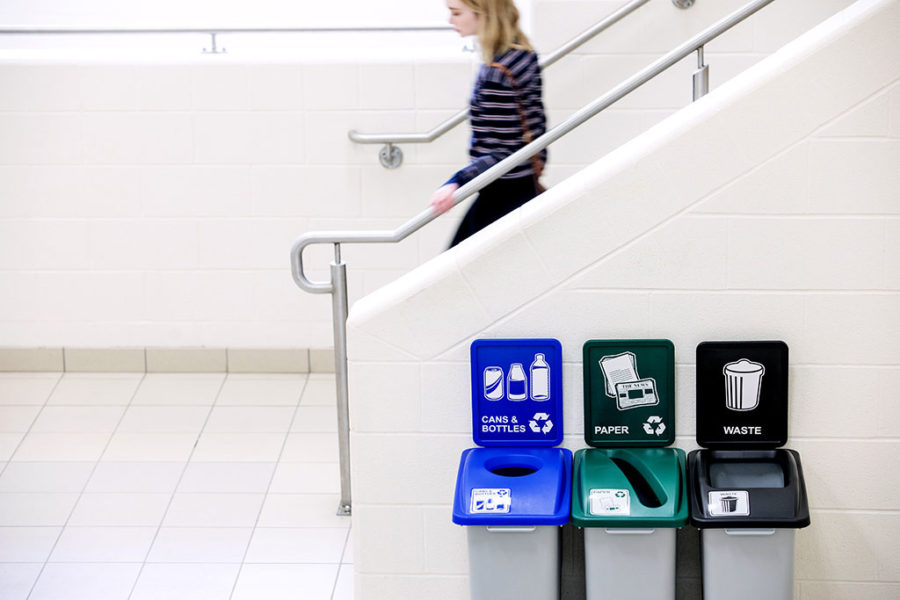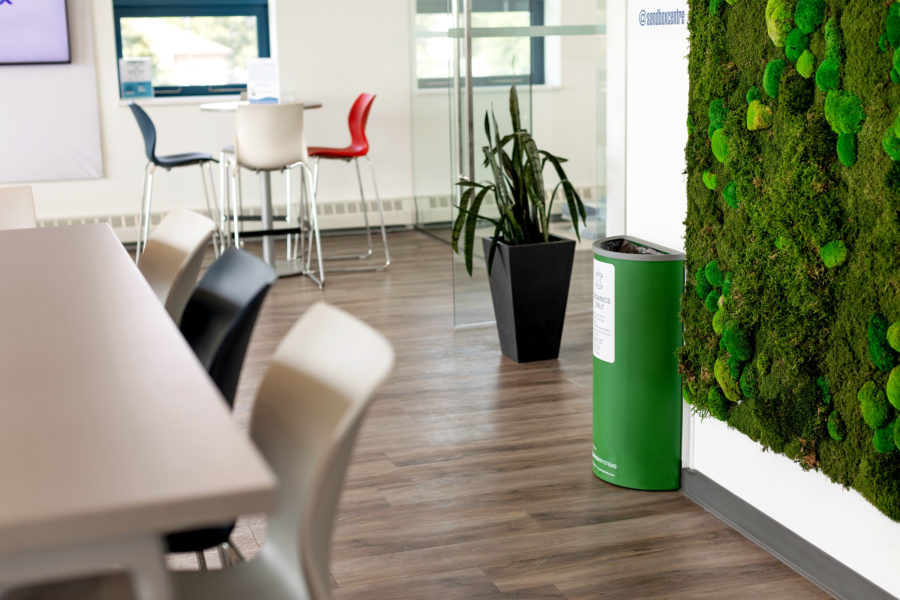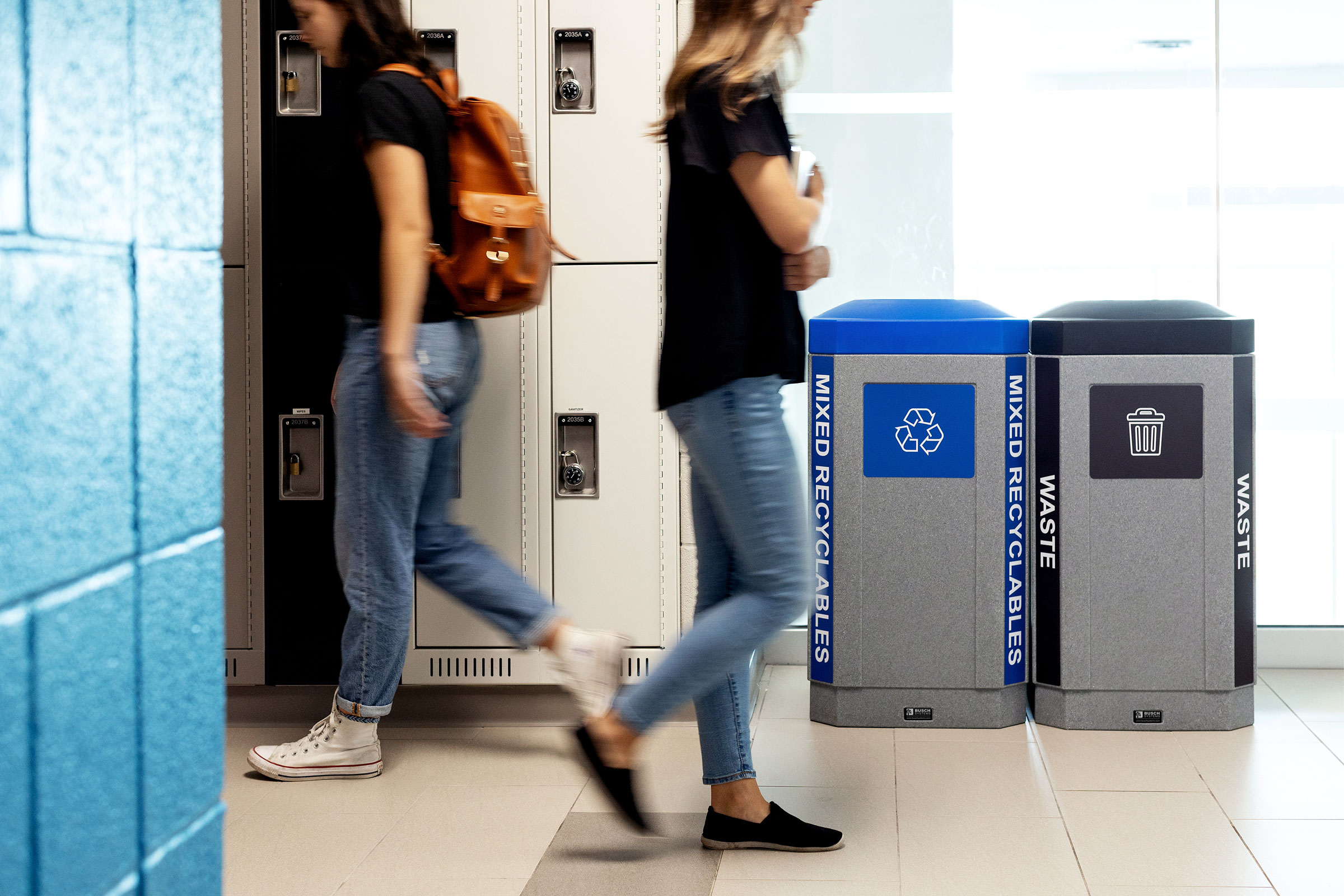Story at a glance:
- Colleges or universities can produce more than 8,000 tons of waste a year. Of that, 50% or more can be recycled and 20% or more composted.
- Recycling programs are more successful when bins are a distinct color, have clear/visible signage, and have restrictive openings.
- Form meets function at Busch Systems, where waste system options are fully customizable and aesthetically pleasing.
Anyone can set out a bin and label it “recycling” or “trash,” but that doesn’t mean people will follow directions, especially since it’s not always clear what qualifies as recyclable. Features like colored bins, visible/clear signage, and restrictive openings can be the difference between a recycling program that’s successful and one that isn’t.
That has always been the vision of the founder of Busch Systems®, Craig Busch—make recycling more accessible and functional. When Busch was a student at York University in Toronto in 1983, the first curbside recycling programs were implemented in Kitchener, Ontario. Busch immediately saw a need for improvement. The receptacles were heavy and difficult to use. By 1985 Busch had started Busch Systems, coming to market with a lighter, more durable recycling bin. By 1990 the company was supplying a quarter of the blue curbside recycling boxes used in Canada and many in the US.
The company didn’t stop there. Learning more about user behavior, custodial convenience, and aesthetic needs has led Busch to expand offerings to serve everyone from the executive to the student. “Recycling and waste reduction is the cornerstone of sustainability. Recycling is one concrete, tangible way people can have less of an impact on the environment,” says Alec Cooley, senior advisor at Busch Systems.
Educational buildings produce a lot of waste. An average K-12 school produces around 30 to 40 tons of waste per year, a larger high school can generate twice that, and a large college or university can generate 7,500 or more tons of waste per year. A high percentage of that waste is recyclable—easily 50% or more—and another 20 to 30% could be food or organic material to be composted. “There is a difference between setting up bins that collect waste and having a program that is higher performing and does a better job of recovering and collecting the right kind of recyclable. The way bins are designed and set up has a big impact on how people participate,” Cooley says.
Best Practices for Best Results

Color is an important component for recycling and waste systems. Photo courtesy of Busch Systems
There is often a misconception about recycling and waste-diversion programs. The assumption is that it is not complicated. It doesn’t take much knowledge to put trash in a bin. “While that is true for trash, it is not for recycling,” Cooley says. “It is far more complicated how recycling bins are used and used correctly.”
The act of tossing waste into a bin is simple, but when you ask people to start separating items into separate bins, all sorts of decisions and thought processes happen in the moment. First people have to recognize there are separate bins they have to choose between. Next they have to comprehend the basic parameters of what goes into each. There may be a bin for recycling, but is it intended to collect all recyclables or, for example, just paper items? Finally they have to figure out if the item in their hand is, in fact, acceptable within those parameters. A coffee cup may be made of paper but is not technically recyclable in many locations.
While these are simple decisions a child can make, you have to factor in real world conditions where people simply aren’t paying close attention. With only a passing glance to find a bin opening to toss an item, people who are otherwise conscientious to recycle don’t process the information needed to choose the correct bins. The result is recyclables ending up in the trash and vice-versa. That’s why Busch Systems follows best practices for making recycling more accessible to users—visual prompts, restrictive lids, and prominent signage. “It’s not just how to collect trash and make it go away as efficiently as possible. You want to create the infrastructure that intuitively guides users to use the bin you want them to use,” Cooley says.
As people approach a set of bins, it is important for them to immediately comprehend what is for recycling, trash, and composting. One way to do this is by color. There is no official color standard across the US and Canada, but there is a growing trend to use blue for recycling, green for food/composting, and gray or black for trash. Color prompts people—telling them they have a decision to make. This is backed up by science. In a 2012 University of Michigan study, replacing trash and recycling bins of the same color with bins of separate colors caused the percentage of recyclable items placed in the correct bin to increase from 52 to 88%.

Aura Series recycling and waste receptacles. Photo courtesy of Busch Systems
Restrictive lids also help to guide users. A receptacle for cans or bottles may have a small circular opening to help direct users, or one for paper may have a slot. “You don’t want an opening that is wide so someone can casually discard without paying attention. You want it to be more restrictive so it forces them to focus attention on what they’re doing,” Cooley says. “Restrictive openings improve the percentage of those who recycle and sort correctly.”
Prominent signage that captures attention from several feet away can help to prompt people. It should ideally be placed at eye level and use both words and images to show what goes where. In another study, when special eye level signage was attached to waste bins at the University of Georgia, 18% fewer recyclables ended up in the trash and 14% less trash ended up in the recycling bin.
Consistency is also important. If you have different styles of bins, colors, or signage across various spaces, you only increase confusion. Visual uniformity ensures people don’t have to put a lot of thought into what they are supposed to do as they move locations.
What are My Options?

Renegade Bins are a new single stream, durable, and cost-effective container option with high capacity for waste and recycling collection.
Photo courtesy of Busch Systems
Busch Systems offers hundreds of options depending on setting and waste program requirements. The company has single units, arranged cabinets, multi-chamber containers, and more across price points. It offers aesthetically pleasing, fully customizable, and highly innovative options to meet all needs.
Its most customizable recycling and waste station option is the Waste Watcher® series. It comes in different sizes, colors, openings, and signage options. The Waste Watcher evolves with programs as it is easy to add or remove streams and features. It is ideal for the college campus, grade school, office, or government building.
For those looking to further sustainability goals, the Aspyre Collection is made of 100% recycled plastic lumber—for every pound of lumber, 10 milk jugs were recycled. It is highly durable with stainless steel, rust-resistant hinges, and heavy-duty screws. It also has a variety of color and opening selections to fit any space.
The Rise Series is another beautiful option. The wall-mounted, low-profile container brings recycling up to your desired height and leaves the floor clear. It is easily installed with metal brackets and is compact to fit in small spaces. Those looking for more aesthetically pleasing options might turn to the Spectrum® Series for a modular container in vivid color and endless opportunities for customization. Or the Aristata® Series for more style and sophistication. It comes in five finishes designed to blend seamlessly in any space.
Renegade Bins are a new single stream, durable, and cost-effective container option with high capacity for waste and recycling collection. These are ideal for outdoor locations, as they hold up to harsher weather conditions. The outdoor bins are made with 100% post-consumer recycled content and designed with a rain hood that will help precipitation roll off the top of the bin.
Servicing waste bins is also easier with Busch Systems. Bins are designed so liners are quick to secure and don’t fall to the bottom. Larger capacity bins have the option to empty from the side, making them more ergonomic.
Design Flexibility

Photo courtesy of Busch Systems
At top of mind for designers is how to strike a balance between form and function. But for recycling infrastructure, form is function. People must follow best practices for color and signage to get the best results. “It gets to the heart of how people will use the infrastructure,” Cooley says. “If the bins don’t prompt people correctly, you have a system that underperforms.”
At Busch Systems it is possible to align best practices with form and have an attractive bin that directs people correctly. “We prioritize form and function the same,” he says. “We know aesthetics are important. We all want the infrastructure to look attractive. We know if bins don’t look attractive people will hide or push them out of the way. And that can impact program success.”
Designers partner with customers to understand their waste programs and determine aesthetic needs. The company has many off-the-shelf options, but they also offer customized colors and other attributes to help fit design visions. Most of Busch’s product line is composed of recycled materials. All products are made in North America and recyclable at the end of life.

